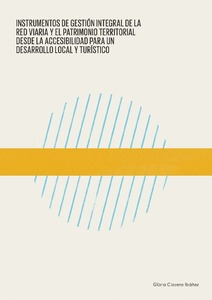Mostra el registre d'ítem simple
Instrumentos de gestión integral de la red viaria y el patrimonio territorial desde la accesibilidad para un desarrollo local y turístico
| dc.contributor | Magrinyà Torner, Francesc |
| dc.contributor.author | Clavera Ibáñez, Glòria |
| dc.contributor.other | Universitat Politècnica de Catalunya. Institut Universitari de Recerca en Ciència i Tecnologies de la Sostenibilitat |
| dc.coverage.spatial | east=2.0304107666015625; north=41.38814294931545; name=Llobregat Sur, Barcelona, Espanya |
| dc.coverage.spatial | east=0.8953857421875; north=41.629814503758624; name=Pla d'Urgell, Lleida, Espanya |
| dc.coverage.spatial | east=1.856689453125; north=42.17968819665961; name=Alt Berguedà, Barcelona, Espanya |
| dc.date.accessioned | 2017-09-13T07:44:18Z |
| dc.date.available | 2017-09-13T07:44:18Z |
| dc.date.issued | 2017-07-18 |
| dc.identifier.citation | Clavera Ibáñez, G. Instrumentos de gestión integral de la red viaria y el patrimonio territorial desde la accesibilidad para un desarrollo local y turístico. Tesi doctoral, UPC, Institut Universitari de Recerca en Ciència i Tecnologies de la Sostenibilitat, 2017. DOI 10.5821/dissertation-2117-107705. |
| dc.identifier.uri | http://hdl.handle.net/2117/107705 |
| dc.description.abstract | The road network service for mobility should respond to the challenges of sustainability and the new way of understanding the territory from a systemic, historical and topological perspective. In order to accomplish this goal, the management must give service to the active resources of the territory from a local approach and it must be responsible for the multiple users of the network. In view of this, what tools exist to change the current road network into one which is local and sustainable? A number of strategies of this line of proceeding have been identified through the analysis of the current accessibility of the heritage resources of three different areas. In addition, it has brought to the surface elements involved in the process and has given added value to actors and operators as promoters of its dynamism. Together with this analysis which contains proposals, the essential criteria applied for defining the road network has borne in mind its potential for walkability and connectivity to territorial resources. Taking into account pedestrians in non-urban areas, management strategies must focus on improving minor roads so that they are safer and continuous. They should also link local territorial resources and make exogenuous and touristic needs compatible with everyday endogenous functionality. There are three parameters in this research based on territoriality which are considered essential in the management of road network: intermodality, continuity and functionality. These parameters are key for the development of a more pedestrian friendly road network which articulates the heritage and cultural subsystem of a local territory. |
| dc.description.abstract | La red viaria que da servicio a la movilidad debe responder a los retos de la sostenibilidad y a la nueva manera de entender el territorio desde una lectura sistémica, histórica y topológica. La respuesta es una red viaria de enfoque local que de servicio a los recursos activos del territorio y cuya gestión se comprometa con los múltiples usuarios de la red. Ante esto, ¿qué herramientas existen para transformar la red viaria vigente hacia una red sostenible y de proximidad? A través del análisis de la accesibilidad a los recursos patrimoniales de tres entornos diferenciados se han identificado una serie de estrategias de actuación vigentes en esta línea. Asimismo, el análisis ha hecho emerger los estratos intervinientes en el proceso de la accesibilidad patrimonial dando especial valor a los actores y los operadores como activadores de su dinamismo. Junto con el análisis propositivo se ha caracterizado la red viaria local según su potencial a la peatonalidad y a la conectividad de los recursos territoriales. Si se centra la mirada en el usuario peatón en un entorno no-urbano las estrategias de gestión deben dirigirse hacia la adecuación del viario intermedio para el uso seguro y continuo del peatón, la articulación de los recursos del territorio local y la compatibilización de la funcionalidad cotidiana endógena con la exógena y turística. En esta investigación se proponen la intermodalidad, la continuidad y la funcionalidad basada en la territorialidad como los parámetros puntales a tener en cuenta al acondicionar la red viaria para el uso del peatón y convertirla en una red que articule el sub-sistema patrimonial y cultural del territorio local |
| dc.format.extent | 284 p. |
| dc.language.iso | spa |
| dc.publisher | Universitat Politècnica de Catalunya |
| dc.rights | L'accés als continguts d'aquesta tesi queda condicionat a l'acceptació de les condicions d'ús establertes per la següent llicència Creative Commons: http://creativecommons.org/licenses/by/4.0/ |
| dc.rights.uri | http://creativecommons.org/licenses/by/4.0/ |
| dc.source | TDX (Tesis Doctorals en Xarxa) |
| dc.subject | Àrees temàtiques de la UPC::Desenvolupament humà i sostenible |
| dc.subject.other | Territorial system |
| dc.subject.other | Sustainable local development |
| dc.subject.other | Territorial capital |
| dc.subject.other | Heritage |
| dc.subject.other | Accessibility |
| dc.subject.other | Sistema territorial |
| dc.subject.other | Desarrollo local sostenible |
| dc.subject.other | Patrimonio |
| dc.subject.other | Accesibilidad |
| dc.subject.other | Turismo cultural |
| dc.title | Instrumentos de gestión integral de la red viaria y el patrimonio territorial desde la accesibilidad para un desarrollo local y turístico |
| dc.type | Doctoral thesis |
| dc.identifier.doi | 10.5821/dissertation-2117-107705 |
| dc.rights.access | Open Access |
| dc.description.version | Postprint (published version) |
| dc.identifier.tdx | http://hdl.handle.net/10803/405566 |



